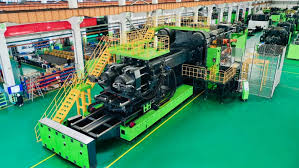In the realm of manufacturing, molding machines are essential the best injection molding machine for producing a vast array of products across different industries. These machines shape materials into desired forms using molds, making them indispensable in the production of everything from plastic components to metal parts. This article delves into the various types of molding machines, their applications, and the benefits they bring to modern manufacturing.
Types of Molding Machines
- Injection Molding MachinesInjection molding is one of the most popular methods for producing high-volume plastic parts. In this process, plastic pellets are melted and injected into a mold under high pressure. The material cools and solidifies, taking the shape of the mold cavity. Injection molding machines are favored for their precision, repeatability, and efficiency, making them ideal for producing intricate parts with tight tolerances.
- Blow Molding MachinesBlow molding is used to manufacture hollow plastic objects, such as bottles and containers. This process involves inflating a heated plastic tube (preform) inside a mold. The air pressure causes the plastic to conform to the shape of the mold, creating hollow objects. Blow molding machines are commonly used in the packaging industry due to their ability to produce lightweight, durable containers.
- Compression Molding MachinesCompression molding is a technique where a pre-measured amount of material (often thermosetting plastic) is placed into an open mold cavity. The mold is then closed, and heat and pressure are applied to cure the material. This method is widely used for producing large, complex parts and is often employed in the automotive and aerospace industries. Compression molding machines offer excellent surface finish and dimensional accuracy.
- Rotational Molding MachinesRotational molding, or rotomolding, involves heating a plastic powder or resin inside a mold while rotating it along two axes. The rotation ensures an even distribution of material, which is then cooled to form a hollow part. Rotational molding machines are used to produce large, hollow items like tanks, playground equipment, and automotive parts.
- Extrusion Molding MachinesIn extrusion molding, plastic is melted and forced through a mold to create long, continuous shapes, such as pipes, sheets, and profiles. The material is then cut or cooled to the desired length. Extrusion molding machines are highly efficient for producing uniform cross-sectional profiles and are commonly used in the construction and packaging industries.
Applications of Molding Machines
Molding machines have diverse applications across various industries:
- Automotive Industry: Used for manufacturing components such as dashboards, bumpers, and interior trim parts.
- Packaging Industry: Essential for producing containers, bottles, and packaging materials.
- Consumer Goods: Used to create everyday items like toys, household appliances, and electronics casings.
- Medical Devices: Employed in the production of precision components for medical equipment and devices.
- Construction: Utilized for making plastic pipes, fittings, and other construction materials.
Benefits of Molding Machines
- High Efficiency: Molding machines are designed to produce large quantities of parts quickly and consistently. This efficiency is crucial for meeting the demands of high-volume production runs.
- Precision and Consistency: Modern molding machines offer high precision, ensuring that each part produced meets exact specifications. This consistency is essential for industries where quality and performance are critical.
- Cost-Effectiveness: While the initial investment in molding machines can be significant, their ability to produce parts with minimal waste and high speed results in cost savings over time.
- Versatility: Molding machines can handle a wide range of materials, including plastics, metals, and composites. This versatility allows manufacturers to explore different materials and product designs.
- Complex Geometries: Molding processes can produce parts with complex shapes and intricate details, which would be difficult or impossible to achieve using other manufacturing methods.
Conclusion
Molding machines are a cornerstone of modern manufacturing, offering efficiency, precision, and versatility across various industries. Whether producing plastic components, metal parts, or hollow objects, these machines play a crucial role in shaping the products that define our daily lives. Understanding the different types of molding machines and their applications can help manufacturers select the right equipment for their needs, ensuring optimal performance and quality in their production processes.

